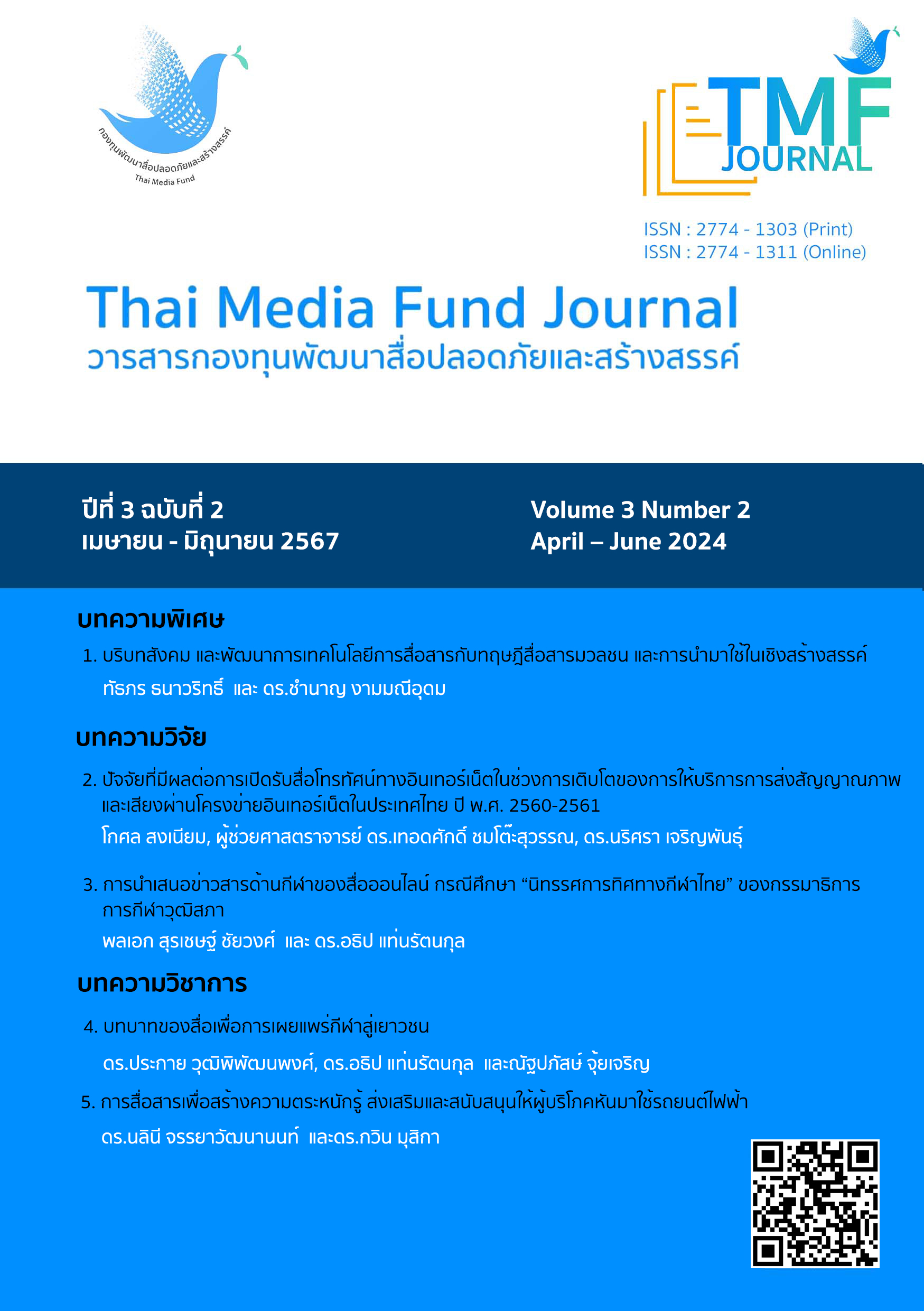บทบาทของสื่อเพื่อการเผยแพร่กีฬาสู่เยาวชน
Main Article Content
บทคัดย่อ
บทความนี้ผู้เขียนมีวัตถุประสงค์ที่จะนำเสนอถึงแนวทางการสื่อสารและประชาสัมพันธ์เพื่อสร้างการรับรู้และตระหนักในความสำคัญของกีฬาในหมู่เยาวชนที่กำลังจะเติบโตขึ้นไปเป็นพลเมืองที่ดีมีคุณภาพในอนาคต โดยผู้เขียนได้ศึกษาถึงแนวคิดการแบ่งช่วงอายุของคน รวมถึงประโยชน์ของกีฬาที่มีต่อเยาวชน แนวคิดเกี่ยวกับสื่อและกระบวนการตัดสินใจซื้อ ซึ่งจะมีผลต่อการตัดสินใจเลือกของเยาวชนต่อกีฬาแต่ละประเภท ซึ่งเป็นที่ยอมรับโดยทั่วกันว่ากีฬามีประโยชน์ต่อคนในหลายช่วงวัยโดยเฉพาะเยาวชน โดยกีฬาจะช่วยให้เกิดการสร้างความร่วมมือและการทำงานเป็นทีมส่งผลให้เกิดการสร้างมูลค่าทางสังคม มากกว่านั้น กีฬายังช่วยสร้างความเข้าใจในการยอมรับความแตกต่างทั้งด้านอายุ เพศและระดับของการศึกษาซึ่งเป็นคุณค่าพื้นฐานในสังคม กีฬาช่วยส่งเสริมให้รู้จักความเป็นธรรมและความเท่าเทียม สุขภาพกายและใจ รวมไปถึงการแสดงออกด้วยความเป็นมืออาชีพ โดยผู้ที่ชอบเล่นกีฬาจะทำให้มีสุขภาพที่ดีและสามารถที่จะพัฒนาทักษะในกีฬาประเภทต่าง ๆ ไปสู่ความเป็นเลิศได้ ซึ่งในปัจจุบันการสื่อสารและประชาสัมพันธ์เพื่อสร้างการรับรู้และตระหนักในความสำคัญของกีฬานั้นสามารถที่จะกระทำได้ในหลายวิธี โดยสื่อคือตัวกลางที่มีบทบาทสำคัญในการส่งเสริมกิจกรรมกีฬาและเชื่อมโยงกิจกรรมสันทนาการในรูปแบบต่าง ๆ เข้ากับกลุ่มเยาวชน โดย 1) สื่อมีบทบาทสำคัญในการช่วยให้กลุ่มเยาวชนได้ตระหนักถึงประเภทของกีฬาที่เหมาะสมและเป็นประโยชน์ต่อตนเองซึ่งสอดคล้องกับความสนใจและระดับความสามารถในการเล่นกีฬาของแต่ละบุคคล 2) สื่อมีบทบาทสำคัญเพื่อช่วยให้ตัดสินใจเลือกกีฬาหรือกิจกรรมที่เหมาะสมที่สุดตามความสนใจและความพร้อม 3) สื่อมีบทบาทสำคัญในการช่วยสร้างความประทับใจที่ดีต่อการเล่นกีฬาหรือกิจกรรมที่เลือก 4) สื่อมีบทบาทสำคัญในการกระตุ้นความสนใจและการให้คำแนะนำเพื่อให้กลุ่มเยาวชนมีประสบการณ์ที่ดีจากกีฬาหรือกิจกรรมทางกายที่เลือก และ 5) สื่อมีบทบาทในการส่งเสริมและให้ข้อมูลเพื่อสนับสนุนการตัดสินใจเลือกกีฬาที่เหมาะสมที่สุดสำหรับกลุ่มเยาวชน
Article Details

อนุญาตภายใต้เงื่อนไข Creative Commons Attribution-NonCommercial-NoDerivatives 4.0 International License.
เอกสารอ้างอิง
American Heart Association. (2021). physical activity and cardiovascular health. Retrieved from: https://www.heart.org/en/healthy-living/fitness/fitness-basics/physical-activity-and-your-heart
Anderson, L. (2020). Coverage of political events in mainstream newspapers. Newspaper Times,
pp. B1-B3.
Arnett, J. J. (2000). Emerging adulthood: A theory of development from the late teens through the twenties. American Psychologist, 55(5), 469-480.
Boonpakdee, N. (2024). Thai Health Promotion Foundation reveals that Thai children have problems with "bullying, addiction, and mental health" causing intergenerational problems. Retrieved from https://www.hfocus.org/content/2024/01/29620
Brenner, J., & Hodel, C. (2017). Communication and social media in sports: Overview and research opportunities. Communication & Sport, 5(6),
-650.
Britannica. (2015). List of sports. Retrieved from https://www.britannica.com/topic/list-of-sports-2038581
Brown, T. (2010). The decline of traditional newspapers. Journal of Media History, 12(1), 45-58.
Davis, R. (2018). Historical perspectives on television's influence. Media Archives, pp. 101-115.
Department of Children and Youth. (2022). Five-year operational plan (2023-2027) of the Office of the basic education commission. Bangkok: Strategy and Planning Division, Ministry of Social Development and Human Security.
Department of Children and Youth. (2024). Children and youth situation report for fiscal year 2023. Bangkok: Strategy and Planning Division, Ministry of Social Development and Human Security.
Dithsorn, P. (2023). A study of successful sprots management for local communities. Doctor of Philosophy, Public Enterprise Management, Graduate School of Commerce, Burapha University.
Eccles, J. S., Barber, B. L., Stone, M. R., & Hunt, J. (2003). The Influence of sports participation on adolescent alcohol and illicit drug use. Journal of Adolescent Health, 32(4), 279-288.
Erikson, E. H. (1959). Identity and the life cycle: Selected papers. International Universities Press.
Golzarand, M., & Akbarzadeh, M. (2019). The role of media in sports. Journal of Paramedical Sciences & Rehabilitation, 8(3), 60-70.
Gonzalez, J. (2019). The impact of television on youth culture. Journal of Media Studies, 15(2), 45-56.
Harris, J. (2020). The role of internet media in shaping consumer behavior. Internet Media Quarterly,
pp. B1-B3.
Harvard Health Publishing. (2022). Exercise is an all-natural treatment to fight depression. https://www.health.harvard.edu/mind-and-mood/exercise-is-an-all-natural-treatment-to-fight-depression
Havighurst, R., J. (1972). Developmental tasks and education. New York: David McKay.
Healthline. (2023). the benefits of sports and exercise. Retrieved from https://www.healthline.com/nutrition/10-benefits-of-exercise
Heissel, A., Heinen, D., Brokmeier, L. L., Skarabis, N., Kangas, M., Vancampfort, D., Stubbs, B., Firth, J., Ward, P. B., Rosenbaum, S., Hallgren, M., & Schuch, F. (2023). Exercise as medicine for depressive symptoms? A systematic review and meta-analysis with meta regression. Br J Sports Med, 57(18), 1203-1209.
Johnson, M. (2018). The impact of digital media on society. Journal of New Media Studies, 5(2), 45-58.
Johnson, P. Q. (2017). Media ownership and its impact on mainstream journalism. Publisher.
Kotler, P., & Keller, K. L. (2012). Marketing management (14th ed.). London: Pearson Education.
Nelson, T. F., Stovitz, S. D., Thomas, M. M., & LaVoi, N. M. (2011). Sports participation and health-related behaviors among US youth. Archives of Pediatrics & Adolescent Medicine, 165(10), 898-906.
Office of the National Economics and Social Development Council. (2023). National economic and social development plan No. 13 (2023-2027). Retrieved from https://www.nesdc.go.th/download/Plan13/Doc/Plan13_ Final.pdf
Roberts, S. (2018). Online journalism and its impact on public discourse. Digital Journalism Review, 5(3), 101-115.
Secondary Education Area Office District 36. (2019). Student support system handbook. Chiang rai: Secondary Education Area Office District 36.
Smith, A. B. (2008). Mass communication and society. Publisher.
Smith, A. B. (2019). Emerging trends in online journalism. Digital News Quarterly, 15(3), 112-125.
Smith, J. (2015). The influence of mainstream media on public opinion. Journal of Communication Studies, 25(3), 112-125.
SportsRec. (2011). Different kinds of sports. Retrieved from https://www.sportsrec.com/different-kinds-sports-8468079.html
Steinberg, L. (2008). Adolescence. Boston: McGraw-Hill Education.
The Aspen Institute. (2015). Sport for All, Play for Life: A playbook to get every kid in the game. Retrieved from https://www.aspeninstitute.org/wp-content/uploads/2015/01/Aspen-Institute-Project-Play-Report.pdf
Thompson, L. (2017). The influence of internet media on public opinion. Journal of Internet Studies, 10(2), 45-58.
Trost, S., Khan, K. m., & Blair, S. N. (2014). Physical inactivity remains the greatest public health problem of the 21st century: Evidence, improved methods and solutions using the '7 investments that work' as a framework. British Journal of Sports Medicine 48(3), 169-70.
UNICEF Thailand. (2019). Develop youth to be ready for the future with confidence. Retrieved from https://www.unicef.org/thailand/th/stories/พัฒนาเยาวชนให้พร้อมรับมือกับอนาคตได้อย่างมั่นใจ
Veliz, P., McCabe, S. E., & Boyd, C. J. (2015). Sports participation and substance use among adolescents: The impact of level of involvement and sport type. Journal of Adolescent Health, 56(3), 276-282.
White, S. (2013). Impact of radio broadcasting in the 20th century. New York: Routledge.
Williams, C. (2020). The future of digital media platforms. Online Media Perspectives, pp. A1-A5.


